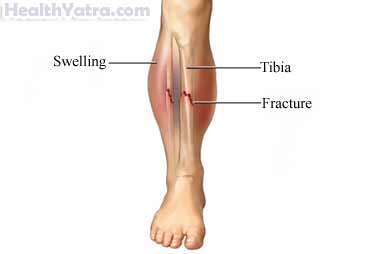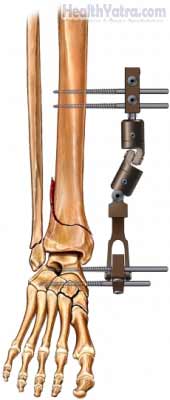Definition
A shinbone fracture is a break in the tibia (shinbone). The lower leg has two bones that connect the knee to the ankle: the tibia and the fibula. The tibia is the larger of the two bones and runs on the inside of the lower leg. The fibula is much smaller and runs along the outside of the lower leg.

Causes
A shinbone fracture is caused by trauma to the shinbone. Trauma includes:
- Falls
- Twists
- Blows
- Collisions
- Gunshot wounds
Risk Factors
A risk factor is something that increases your chance of getting a disease, condition, or injury.
- Advancing age
- Osteoporosis
- Decreased muscle mass
- Certain diseases and conditions that weaken bones, such as tumors
- Participation in certain contact sports, such as football or soccer
- Violence, such as car or car-pedestrian accidents
Symptoms
Symptoms include:
- Severe pain
- Swelling and tenderness
- Bruising in the injured area
- Decreased range of motion of the knee or ankle
- Usually an inability to bear weight on the fractured leg
Diagnosis
The doctor will ask about your symptoms, physical activity, and how the injury occurred. The doctor will examine the injured area.
Tests may include:
- X-rays—a test that uses radiation to take a picture of structures inside the body, especially bones, to look for a break in the bone
- CT scan—a special x-ray that allows more detailed imaging
Treatment
Treatment will depend on the severity of the injury. Treatment involves:
- Putting the pieces of the bone back in place, which may require anesthesia and/or surgery
- Keeping the pieces together while the bone heals itself
Devices that may be used to hold the bone in place while it heals include:
- A cast (may be used with or without surgery)
- A metal plate with screws (requires surgery)
- Screws alone (requires surgery)
- A rod down the middle of the bone (requires surgery)
- Metal pins across the bone with a frame holding them outside the bone (requires surgery)

The doctor may prescribe pain medication depending on the level of pain. Your doctor will order more x-rays while the bone heals to ensure that the bones have not shifted position.
Exercises
When your doctor decides you are ready, start range-of-motion and strengthening exercises. You may be referred to a physical therapist to assist you with these exercises. Do not return to sports until your leg is fully healed and leg muscle strength is back to normal.
Healing Time
A shinbone fracture can take many weeks to heal, but more severe or open fractures may take several months.
If you are diagnosed with a shinbone fracture, follow your doctor’s instructions.
Prevention
To help prevent shinbone fractures:
- Do not put yourself at risk for trauma to the bone.
- Eat a diet rich in calcium and vitamin D.
- Do weight-bearing exercises to build strong bones.
- Build strong muscles to prevent falls and to stay active and agile.
- Wear proper padding and safety equipment when participating in sports or activities.
